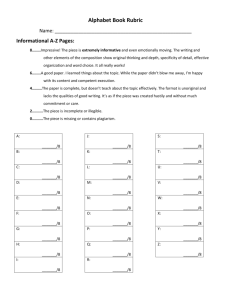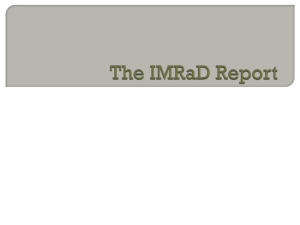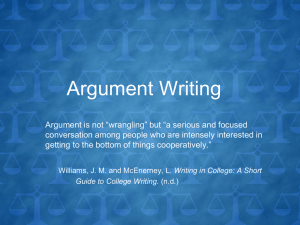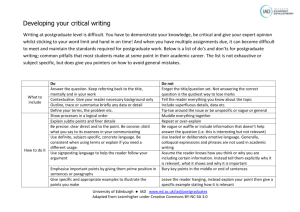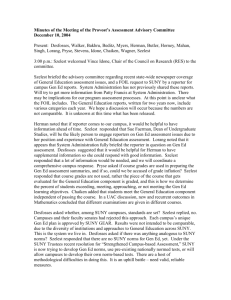Case Study - SUNY Cobleskill
advertisement
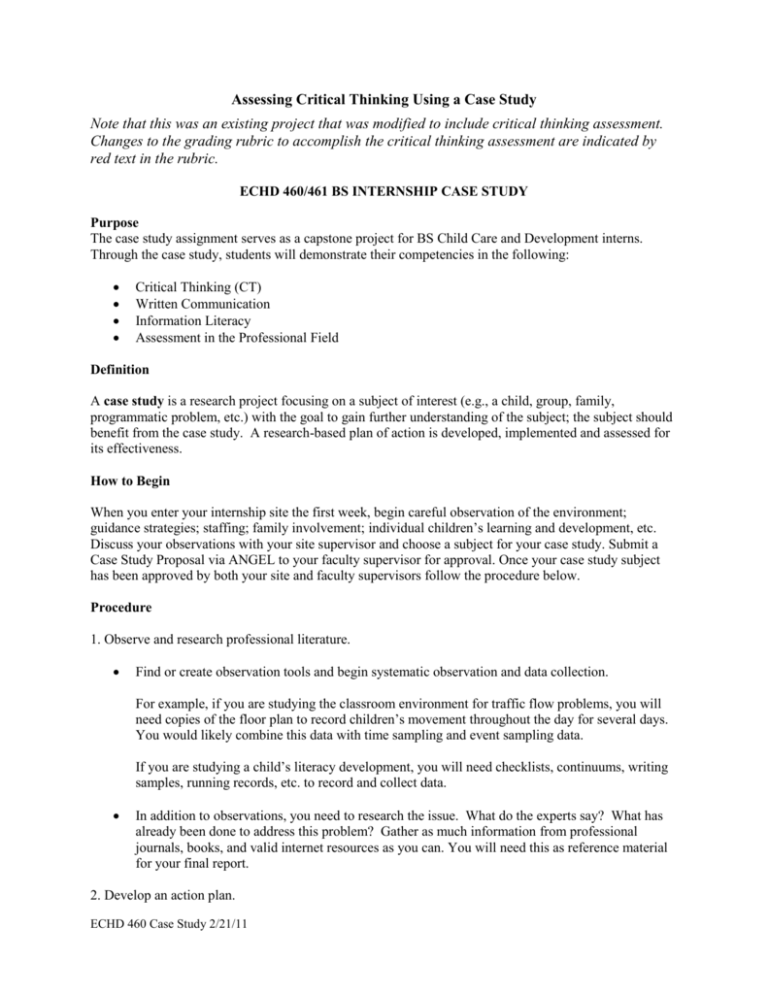
Assessing Critical Thinking Using a Case Study Note that this was an existing project that was modified to include critical thinking assessment. Changes to the grading rubric to accomplish the critical thinking assessment are indicated by red text in the rubric. ECHD 460/461 BS INTERNSHIP CASE STUDY Purpose The case study assignment serves as a capstone project for BS Child Care and Development interns. Through the case study, students will demonstrate their competencies in the following: Critical Thinking (CT) Written Communication Information Literacy Assessment in the Professional Field Definition A case study is a research project focusing on a subject of interest (e.g., a child, group, family, programmatic problem, etc.) with the goal to gain further understanding of the subject; the subject should benefit from the case study. A research-based plan of action is developed, implemented and assessed for its effectiveness. How to Begin When you enter your internship site the first week, begin careful observation of the environment; guidance strategies; staffing; family involvement; individual children’s learning and development, etc. Discuss your observations with your site supervisor and choose a subject for your case study. Submit a Case Study Proposal via ANGEL to your faculty supervisor for approval. Once your case study subject has been approved by both your site and faculty supervisors follow the procedure below. Procedure 1. Observe and research professional literature. Find or create observation tools and begin systematic observation and data collection. For example, if you are studying the classroom environment for traffic flow problems, you will need copies of the floor plan to record children’s movement throughout the day for several days. You would likely combine this data with time sampling and event sampling data. If you are studying a child’s literacy development, you will need checklists, continuums, writing samples, running records, etc. to record and collect data. In addition to observations, you need to research the issue. What do the experts say? What has already been done to address this problem? Gather as much information from professional journals, books, and valid internet resources as you can. You will need this as reference material for your final report. 2. Develop an action plan. ECHD 460 Case Study 2/21/11 Once you have done systematic observation and research, you are ready to develop an action plan. Based on the research and what you have observed at your site, what would you suggest as a plan of action that would effect change and produce a positive result? For example, if you researched a classroom traffic flow problem you may have found information about the effect of environment on children’s choices and behavior. As an action plan you may then decide to rearrange the room to see if this affects children’s behavior in a positive way. If you researched the impact of a social service program on a family, you may have found that professional follow-up is critical. You may then design a new follow-up protocol for your agency and survey families and site staff to gauge its effectiveness. 3. Implement the action plan. Put your plan into action and continue to collect systematic observation data. Keep all the raw data so you can interpret it and determine if your plan had the desired outcomes. You will need to refer to this data when you write up your results. 4. Assess the effectiveness of the action plan. Carefully review and analyze all of your observation data to assess the plan’s effectiveness. Was it successful? How do you define success? Consult with your site supervisor, too. What does s/he think? 5. Summarize results. Write a report about the results of your case study and the action plan. Refer to professional literature and your data to validate your statements. 6. Make recommendations for the future. Based on your results, what would you recommend for continued work with this case study? Would you continue with your plan? Would you change it? Explain. 7. Write a Case Study Report using the following outline: I. II. III. IV. V. VI. VII. VIII. IX. Introduction Objective Description of the Case (i.e. the issue; the child, etc.) Definitions of Terminology (important terms for reader would need to know, reference professional literature) Plan of Action and Rationale (reference professional literature) Implementation of Plan of Action Results Conclusions and Future Recommendations (reference professional literature) References Appendices (optional) ECHD 460 Case Study 2/21/11 ECHD 461 CASE STUDY RUBRIC NAME________________________________________ 1. Introduction 2. Objective Description of the Case CT 1 DOES NOT MEET EXPECTATIONS 0pts. No attempt was made to provide an introduction. No attempt to describe the case with anything other than opinion. SUNY Gen Ed Critical Thinking outcome #1 PLACEMENT_____________________________________ DATE______________ PARTIALLY MEETS EXPECTATIONS 1pt. An attempt was made to provide an introduction to the case study. Minimal information was given about the site, providing little context for the case study. The description of the case was based mainly on opinion with little attention to facts. Unsatisfactory ability to identify a case study subject. MEETS EXPECTATIONS 2pts. An appropriate introduction was written giving the reader some background of the site as context of the case study. A description of the case was presented using facts with some opinion. Satisfactory ability to identify a case study subject. EXCEEDS EXPECTATIONS 3pts. The student wrote a clear, concise introduction to the case study, giving the reader an informed background of the site as context of the case study. A description of the case was presented with details based on facts only. Strong ability to identify a case study subject. 3. Definitions of Terminology No terms were defined. Some terms a reader would need clarification for were defined. Most terms a reader would need clarification for were defined. All terms a reader would need clarification for were thoroughly and accurately defined. 4. Plan of Action and Rationale based on Professional Literature No rationale or No plan of action presented. No reference to data (observation) and/or professional literature. A rationale and/ or a plan of action was articulated. Little attempt to include references to data (observation) and/or professional literature. Less than 3 sources. Argument was unsatisfactory, not supported with logical reasoning. A rationale for the case study was given and a plan of action articulated. Some reference to data (observation) and professional literature included 3-4 sources. A satisfactory argument was developed but reasoning was somewhat weak. A clear and concise rationale was given for the case study and a plan of action articulated based on data (observation) and references from professional literature- at least 5 sources. A well-reasoned argument was developed. CT 2 SUNY Gen Ed Critical Thinking outcome #2 2/28/11 gw 5. Implementation of Action Plan No organized review of the implementation of the plan. The events were written without regard to actual sequence of occurrence. A basic step-by-step sequence of events was given with minimal attention to detail. A step-by-step sequence of events was detailed explaining how the plan of action was implemented. 6. Results To results were presented. The results were based on observations rather than data collected by appropriate evaluation tools. Unsatisfactory ability to analyze and evaluate data. The results were appropriately presented and were based on observations, evaluation tools, and an elemental level of analysis of the data. Satisfactory ability to analyze and evaluate data. The results were presented as factual statements, based on objective observations, appropriate evaluation tools, and an analysis of the data collected. Strong ability to analyze and evaluate data. No conclusions and/ or recommendations were presented. Conclusions and/ or recommendations were presented without support of data analysis or professional research. Argument was not supported with logical reasoning. Conclusions and future recommendations were presented based on the results of the implementation of the action plan. An acceptable argument was developed but more reasoning needed. After careful review of the data and research of professional literature, conclusions were presented and future recommendations supported by the data were given. A wellreasoned argument was developed. No references were included. Some citations were used without a reference or references were included that had no citation. APA formatting was not used. Inappropriate references were used. All citations had a supporting reference. References were given without a citation. Most citations and references were documented properly using APA formatting. Most references were from appropriate sources. All citations had a supporting reference. All citations and references were properly documented using APA formatting. All references were from appropriate sources for this case study. Some supporting data was included in an appendix. However, no reference was made in the text to the appendix. Most supporting data was included in an appendix. References to most of the appendices were made in the text. All supporting data was included in an appropriate appendix. References were made in the text to the appendix. CT 1 SUNY Gen Ed Critical Thinking outcome #1 7. Conclusions and Future Recommendations CT 2 SUNY Gen Ed Critical Thinking outcome #2 8. References 9. Appendices 2/28/11 gw 10. Written Communication/ Professional Presentation The outline was not followed or was loosely followed. Did not include one or more of the following: cover page, table of contents. Writing was below college-level, many grammatical or spelling errors. The final paper somewhat followed the outline and included a cover page, and/or a table of contents. Writing was college-level, few grammatical or spelling errors. The final paper followed the assigned outline, had a cover page, a table of contents. Writing was at an advanced collegelevel, no grammatical or spelling errors. Total Points FINAL SCORE = X/30 ___________________ Note 1: CT = Critical Thinking Note 2: Two major student learning outcomes for SUNY General Education Critical Thinking: 2/28/11 gw CT 1 = Students will identify, analyze, and evaluate arguments as they occur in their own and others’ work. CT 2 = Students will develop well-reasoned arguments.

